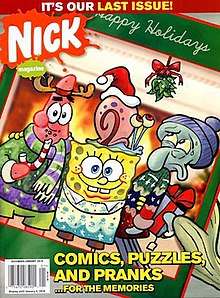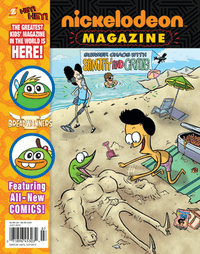Nickelodeon Magazine
Nickelodeon Magazine was an American children's magazine inspired by the children's television network Nickelodeon. Its first incarnation appeared in 1990 and was distributed at participating Pizza Hut restaurants; this version of the magazine only saw two issues. The magazine returned in the summer of 1993 with different type of content, primarily humor and comics. Originally published on a quarterly basis, it switched to bi-monthly with the February/March 1994 issue. It then went to ten times per year starting March 1995, with a bi-annual December/January and June/July issue until its end in 2009.
 | |
 The new Nickelodeon Magazine logo and the December 2009 issue cover. | |
| Editor | Laura Galen (1993–2007) Julie Winterbottom (2007–2009) Greg Herzog (2015–2016) |
|---|---|
| Categories | Children, Entertainment |
| Frequency | Monthly |
| Circulation | Worldwide |
| Publisher | Nickelodeon |
| First issue | 1990 (Pizza Hut) 1993 (standalone) June 2015 (Papercutz) |
| Final issue | 2016 |
| Company | Nickelodeon |
| Country | United States |
| Language | English |
| Website | http://papercutz.com/nickmag |
On February 5, 2015, Papercutz announced that they worked a deal with Nickelodeon to revive the magazine. The new version was first released in June 2015, and new issues were released monthly until 2016.[1]
Format

In spite of being related to the network it was named after, Nickelodeon Magazine covered all sorts of topics, not just what was on the network. The magazine contained informative non-fiction pieces, humor, interviews, comics, pranks and recipes (such as green slime cake). The magazine's mascot was Zelda Van Gutters, a Lakeland Terrier dog who appeared throughout the magazine with sarcastic asides on the articles. She was also the star of the magazine's semi-regular photo comic strip "Ruffing It".
Other contributors included Dan Abdo, John Accurso, Bill Alger, Graham Annable, Ian Baker, Tom Bunk, Martin Cendreda, Greg Cook, Dave Cooper, Jordan Crane, Mark Crilley, Scott Cunningham, Vincent Deporter, Stephen DeStefano, Evan Dorkin, Brent Engstrom, Feggo (Felipe Galindo), Gary Fields, Emily Flake, Ellen Forney, Francho (Arnoldo Franchioni), Dave Fremont, Tom Gauld, Justin Green, Tim Hamilton, Charise Maricle Harper, Paul Karasik, John Kerschbaum, Jacob Lambert, Roger Langridge, Chris Lanier, Robert Leighton, Alec Longstreth, Jason Lutes, Pat Moriarity, Dan Moynihan, Nate Neal, Mark Newgarden, Travis Nichols, Lark Pien, Johnny Ryan, P.Shaw!, Karen Sneider, Israel Sanchez, Jason Shiga, R. Sikoryak, Jen Sorensen, Art Spiegelman, Jay Stephens, Wayno, Todd Webb, Drew Weing, Steve Weissman, Kurt Wolfgang and Gahan Wilson.
In addition, Nickelodeon Magazine's Comic Book also featured comics from characters of the network's programming, which usually appeared just before a season premiere or special film event for the property on the actual series. Among the Nicktoons that were featured in the Comic Book:
- Aaahh!!! Real Monsters
- The Adventures of Jimmy Neutron
- All Grown Up!
- The Angry Beavers
- As Told by Ginger
- Avatar: The Last Airbender
- CatDog
- Catscratch
- ChalkZone
- Danny Phantom
- Doug
- El Tigre: The Adventures of Manny Rivera
- The Fairly OddParents
- Hey Arnold!
- Invader Zim
- KaBlam!
- Mr. Meaty
- My Life as a Teenage Robot
- Oh Yeah! Cartoons
- Pelswick
- Ren & Stimpy
- Rocket Power
- Rocko's Modern Life
- Rugrats
- SpongeBob SquarePants
- The Mighty B!
- The Wild Thornberrys
Nickelodeon Comics
Nickelodeon Comics, formally titled Nickelodeon Magazine Presents, was a series of one-shot special issues put out by Nickelodeon Magazine. Each issue tied in with comics. Nickelodeon Comics mainly contained comics, either newly made stories or two-page shorts reprinted from Nick Magazine, but also featured articles, puzzles, and poster inserts.
Other comics included:
- Fiona of the Felines by Terry LaBan – A girl who is raised by cats. Her strips are occasionally accompanied by a similar strip titled Warren of the Worms.
- Grampa and Julie, Shark Hunters by Jef Czekaj – This strip's titular pair of a girl and her dim-witted grandfather started out searching for Stephen, the Largest Shark in the World. Their adventures from 1999 to 2003 have recently been reprinted in a graphic novel and a Television pilot for an animated series was made by Klasky Csupo.
- Impy & Wormer by James Kochalka – These mini-strips (featured at the bottom of the comic pages, under the regular strips) starred a bug who does not speak proper English and constantly bothers a comparatively intellectual worm.
- Juanita and Clem by Craig Thompson — Whimsical tales of an adventurous little girl (Juanita) and her less brave green friend (Clem).
- Karmopolis by Nick Bertozzi — An adventure strip in a world where everyone and everything is on wheels.
- Mervin the Magnificent by Richard Sala — A bumbling magician named Mervin solves crime with his rabbit sidekick.
- Patty-Cake by Scott Roberts – A bossy little blonde with a flower in her hair.
- Sam Hill & Ray-9 by Mark Martin – A boy and his robot dog.
- Scene But Not Heard by Sam Henderson – The going-ons of a pink man and a bear, who compulsively pull pranks on each other. As the strip's name suggests, the comic is made entirely of pictures with no dialogue or sound effects. In the magazine's tenth anniversary issue, there was a "blooper strip" where the man and bear are talking. Also, there is an advertisement for a Scene But Not Heard musical in Grampa and Julie comic.
- Southern Fried Fugitives by Simon and Kim Deitch – The continuing adventures of a quartet of fried chicken pieces brought to life by a thunderstorm. This strip ended in December 1999.
- Teeny Weeny, the Tiniest Hot Dog in the World by Mark Martin (2005) – A miniature, but enthusiastic, hot dog.
- The Gag Station by various. One-panel gags, often featuring cartoonists such as Johnny Ryan, Mark Newgarden, Ellen Forney, Steve Weissman, Felipe Galindo, Ian Baker and Mark Martin.
- The Uncredibly Confabulated Tales of Lucinda Ziggles by Andy Ristaino — A little girl gets involved in fantastic adventures that nobody ever believes.
- Twiggy Stumps: Outdoor Adventurist by Brian Ralph — A flaky outdoorsman and his wisecracking skunk-pal, Juniper.
- Underpants-On-His-Head Man by Michael Kupperman – Originally appeared as one of "the worst comic book superheroes ever". As his name suggests, he wears his underwear on his head. His archenemy is his coworker, Pants-On-His-Head Man.
- Yam by Corey Barba — A wordless comic starring a toddler with jet backpack, wearing a hoodie, in a whimsical world that features humanlike cats, pet TVs and other fantasy elements.
Posters
Nickelodeon Magazine contained posters in every issue. They were often prank messages for the reader to hang on their bedroom door or elsewhere in their house.
United Kingdom version
A British version of the magazine was published from 16 February 2011 as a collaboration between Nickelodeon and D. C. Thomson & Co. It seems to have been discontinued as of June 2012.
Second Era
Viacom ended operations of the magazine in June 2009 due to economic conditions and the continual move of the network's content to their website.[2] The title continued to publish until the December/January 2010 issue, and the final issue featured an editorial from magazine SVP/Editorial Director Laura Galen thanking the magazine's readers. On February 5, 2015, Papercutz announced that they have worked a deal with Nickelodeon to revive the magazine. The new version was released in June 2015 and ended in 2016.[3]
The following modern Nickelodeon shows represented are:
References
- Larsen, Sven. "Nickelodeon and Papercutz Announce "First Look Deal"". Papercutz. Retrieved 1 June 2015.
- "SpongeBob's still a hit on the screen but a dud on the newsstand". Los Angeles Times. Retrieved 4 September 2013.
- Larsen, Sven. "Nickelodeon and Papercutz Announce "First Look Deal"". Papercutz. Retrieved 1 June 2015.